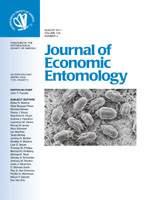The mold mite Tyrophagus putrescentiae (Shrank) is a common pest of stored food products. Until recently, commodity and facility treatments have relied on acaricides and fumigants to control this mite. However, T. putrescentiae will cause infestations in areas where acaricide or fumigant use may be restricted, prohibited, or highly impractical. Because temperature is an essential factor that limits the survival of arthropod species, extreme temperatures can be exploited as an effective method of control. Making low-temperature treatments reliable requires better temperature-time mortality estimates for different stages of this mite. This was accomplished by exposing a representative culture (eggs, nymphs, and adults) of noncold-acclimated T. putrescentiae to subfreezing temperatures to determine their supercooling points (SCPs), lower lethal temperatures (LLTs) and lethal times (LTimes) at set temperatures. The results indicate that the adult and nymphal stages of T. putrescentiae are freeze intolerant; based on 95% CIs, the adult LLT90 of -22.5°C is not significantly different from the SCP of -24.2°C and the nymphal LLT90 of -28.7°C is not significantly different from the SCP of -26.5°C. The egg stage seems to be freeze tolerant, with an LLT90 of -48.1°C, significantly colder by ≈ 13.5°C than its SCP of -35.6°C. The LTime demonstrates that 90% of all mite stages of T. putrescentiae can be controlled within commodity or packaged product by freezing to -18°C for 5 h. By achieving the recommended time and temperature exposures, freezing conditions can be an effective way of controlling mites and reducing chronic infestations.
How to translate text using browser tools
1 August 2011
Freeze Mortality Characteristics of the Mold Mite Tyrophagus putrescentiae, a Significant Pest of Stored Products
Marc Eaton,
Stephen A. Kells
ACCESS THE FULL ARTICLE
It is not available for individual sale.
This article is only available to subscribers.
It is not available for individual sale.
It is not available for individual sale.

Journal of Economic Entomology
Vol. 104 • No. 4
August 2011
Vol. 104 • No. 4
August 2011
Acari
Acaridae
disinfestation
nonchemical control
supercooling point




